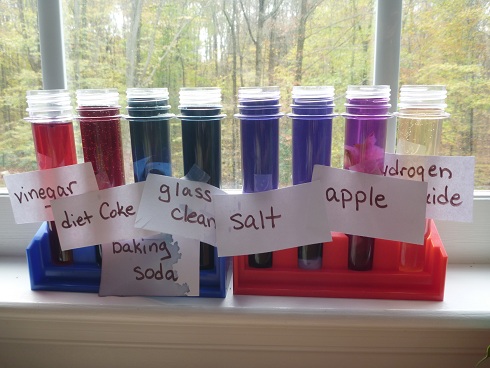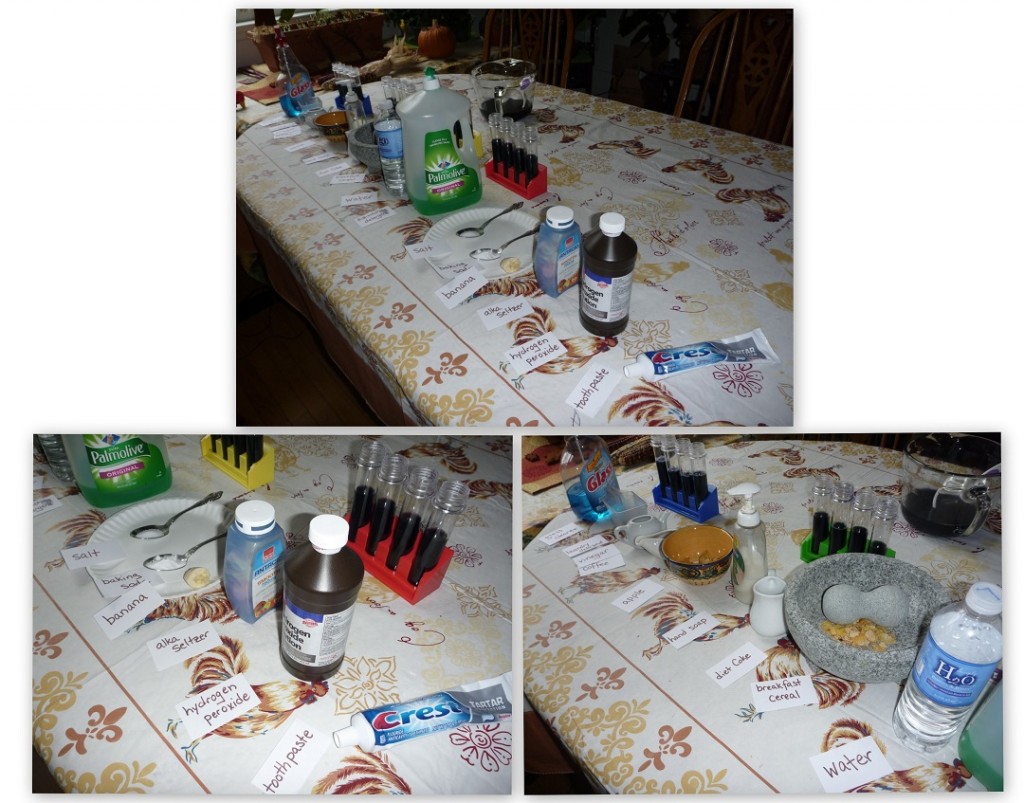Science Experiments: Red Cabbage Indicator (Fun for Ages 4 and Up!)
We did a lot of Montessori science when the older kids were little, so this is an experiment we did years ago. Now the older kids are studying chemistry and ED is the perfect age (4) to enjoy the action of this experiment. Using red cabbage juice as the indicator, you add various household ingredients and compare it to an acid-base chart to see where that particular item falls on the scale.
Before we did the experiment, we read a couple of chapters from Real Science 4 Kids, Chemistry that talked about the differences between acids and bases. (See the picture below, right. You can visit their site for a preview of the student textbook. We don’t have the other materials such as the teacher’s manual, but I really love and highly recommend the textbooks.) I love the cute illustrations that show the bonds between atoms as linked arms. After finishing our reading, I told the kids to write a quick page for their science notebook that shows that bases (often) have an OH group and acids have an H group:
Then we went into the kitchen to explore which household items were acids and which were bases.
First we cut up red cabbage and placed it in a saucepan with water, brought it to a boil, turned off the heat and let it sit for a number of hours.
Then we strained out the cabbage and poured the juice into test tubes.
We had a huge selection of items to test — partly because there are three kids who all want to take part in the action. If I had to narrow down the selection I would recommend
- vinegar
- Diet Coke
- baking soda
- glass cleaner
- apple (but let it soak overnight before really assessing the results)
- hydrogen peroxide (because it bleaches the color out)
Here was our setup:
Before we started adding the ingredients to the test tube, I had the kids decide together which they thought were acids and which were bases.
After adding all the ingredients to the test tubes and labeling them, we looked for the top two most acidic items and the top two bases.
Just so you know, we found the results easier to determine after adding some water to the test tubes because I had let the cabbage sit on the stove for a long, long time and the indicator was quite strong.
You can find the acid-base color chart at Surfing Scientist (page 13) or just google “acid base color indicator chart.”
We used plastic test tubes that we got from Oriental Trading a while back, but of course you can use disposable plastic cups, baby food jars or whatever you have on hand. This was our set up a few years ago:
You can freeze the red cabbage juice for later use.
I put this into a pdf if you’d like to print out my explanation/directions for this experiment.
Making Red Cabbage Acid-Base Indicator-Free Printable
Another wonderful resource is the Surfing Scientist which has much more detail about this experiment.
You might also be interested in these posts from our chemistry unit:
- Water Molecule Attraction
- Red Cabbage – Acid Base Indicator Activity
- Building Molecules: Chemistry Activity
Other fun Chemistry Experiments:
- Chemistry Experiments for Kids (Grade 2) – Matter is Neither Created Nor Destroyed — Acids and Bases – Free Chemistry Experiment Printable Packet
- Chemistry Experiments for Kids (Grade 2) – Mixtures, Chromatography, DNA Kit – Free Chemistry Experiment Printable Packet
- We all enjoyed the IMAX film, Molecules to the Max which is out on DVD (see more about it at this post)
See you again soon here or Homeschool Den Facebook page. Don’t forget to Subscribe to our Homeschool Den Newsletter! ~Liesl


































































1 Response
[…] Red Cabbage – Acid Base Indicator Activity […]